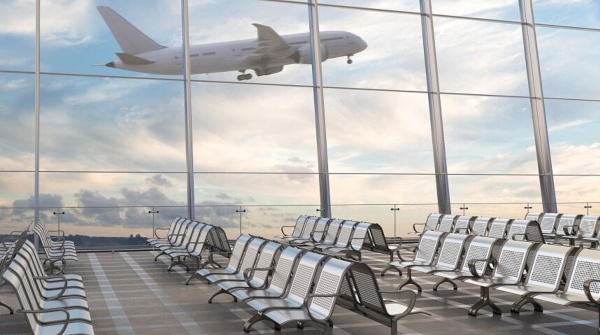Five ways 5G will change the air travel experience

5G has the potential to have a significant impact on the air
travel experience and achieve many process improvements. By improving
everything from passenger handling and security to baggage management and
retail operations, enhanced connectivity will benefit both passengers and
employees.
Long security check lines, long waiting times in retail
stores and restaurants, and unreliable technology (such as slow or unstable
Wi-Fi) can cause frustration and interference for air travel passengers,
airport operators, and service personnel. 5G is the fifth-generation mobile
network, which has the potential to change the rules of the game for air travel
and provide services that can ease passenger barriers and improve operations.
"With low latency and high-speed data connections, air
travel passengers and transportation partners can enjoy a large number of new
features and services at airports and airplanes," said Jerry Traflett,
Verizon's managing partner in retail, travel, and distribution. “From the
navigation of security checkpoints and airport facilities, to the ordering and
payment of goods, food and beverages, to keeping in touch and streaming
content, 5G has the potential to significantly enhance the travel experience.”

This article explores the five main ways airlines, airports,
industry workers, and passengers benefit from this cutting-edge technology, and
what the customer experience will look like in the coming years.
Passenger convenience
Most airline passengers are already using their smartphones
to manage air travel logistics, such as checking in, checking luggage,
accessing mobile boarding passes and receiving flight status updates. 5G can
enhance all these touchpoints-from journey to airport to takeoff by providing
faster network speeds and lower data access latency for mobile-based activities.
From the airport’s point of view, 5G can provide more
powerful features to provide wayfinding applications, personalized mobile
messaging, and other proximity-based digital signage, which can be updated in
near real-time, so passengers can Make the most of your time. For example,
several airports, including Phoenix Sky Harbor (PHX) and New York Kennedy
(JFK), use next-generation connectivity to send messages to remind passengers
and staff about the Covid-19 security agreement.
As passengers pass through the airport, they will be able to
roam seamlessly between the cellular network and Wi-Fi, which will enable the
network to better manage traffic demands, including streaming media and
downloading large files.
Traflet said: “5G allows passengers to have a contactless
and personalized experience throughout the journey.” “Passengers’ smartphones
have become the standard for boarding passes. By opt-in preference, airlines,
airports, and airport companies Personalized information and offers can be
triggered as passengers travel through the airport."
Business connection
Just as high-speed connectivity is as important to
travelers, 5G can provide airport retailers and restaurants with enhanced
services and features.
With faster cloud-based point-of-sale systems and mobile
apps, not to mention self-service kiosks for ordering and paying for food,
beverages and retail, customers and employees alike can benefit from convenient
ordering and payment options because and Faster service. Reducing long or
unpredictable waiting times for airport shopping will increase customer
satisfaction, increase operational efficiency, and increase employee retention.
Inventory management
According to SITA, a leading IT provider in the air
transportation industry, 4G technology can manage approximately 10,000 devices
within one square kilometer. At the same time, 5G networks are expected to
eventually manage as many as 1 million. Imagine the possibility of being able
to confidently connect and track baggage, parcels, pallets and containers, and
all other airport inventory, which constantly passes through security, ground,
plane, and return-all in one go.
Traflet said: "5G allows the use of existing networks,
such as Wi-Fi, while providing a way to adopt more advanced networks, and unleash
the benefits of increased equipment, speed, reliability, and scalability to
support advanced imaging applications." With the ability to seamlessly
connect IoT devices, data can be captured, transmitted, stored, and processed
in near real-time."
Operational efficiency
IoT connectivity will also improve processes that are simple
in theory but involve a lot of work in practice. Everything has potential IoT
applications: optimizing line length; controlling the lighting of runways,
loading areas, and roads; cleaning bathrooms; using self-driving cars to
transport people and luggage through airports and shuttle buses; and more
imaginable.
For example, at Heathrow Airport, British Airways tested an
automated electric tug to automate aircraft taxiing, and the system reduced
delays related to pushback by 53%.
The ability of remote and robot management to perform simple
operations will enable more ground personnel to participate in customer service
activities that require humanization, while improving the passenger experience
and the safety of passengers and agents.
Strong security
Efficient and comprehensive security measures are the top
priority for airport operators and passengers. Since 5G networks can provide
the ability to operate effective and high-quality security systems, airports
can implement high-definition video surveillance to provide a stream of
near-real-time situational data analysis promised by artificial
intelligence-driven security surveillance services.
From a processing point of view, biometric devices can
also rely on 5G for secure entry. Concessions and automated passport scanners
can be used in conjunction with these to reduce labor-intensive screening
through automated processes. In addition, with the consent of the customer, the
airport can use biometric technology (face recognition, fingerprints,
fingerprints) to reduce boarding time.
For example, Face Express allows passengers at Tokyo
Haneda International Airport to check in, pass through security checkpoints,
drop luggage, and board the plane, all of which can be done through facial
recognition scans.
The future of onboard operations
Traflet said: “Although it is still under development and
testing with multiple technology providers, one day it can provide enhanced
connectivity in flight.” “Through high-speed data and communication
transmission, 5G can create better quality streaming services for passengers.
And enhance the capabilities of airline employees."
The ultimate benefit of 5G for air travel will come from the
complete connection of the aircraft itself. More data that is easier to process
and analyze means better maintenance and faster turnaround times, which may
lead to stricter and more predictable scheduling. The ability of pilots to
communicate seamlessly with air traffic control and use enhanced technologies
in the cockpit can improve safety and flight optimization. These features can
also support the continuous development of autonomous flight operations. Of
course, all of these can be transformed into the best traveler experience.